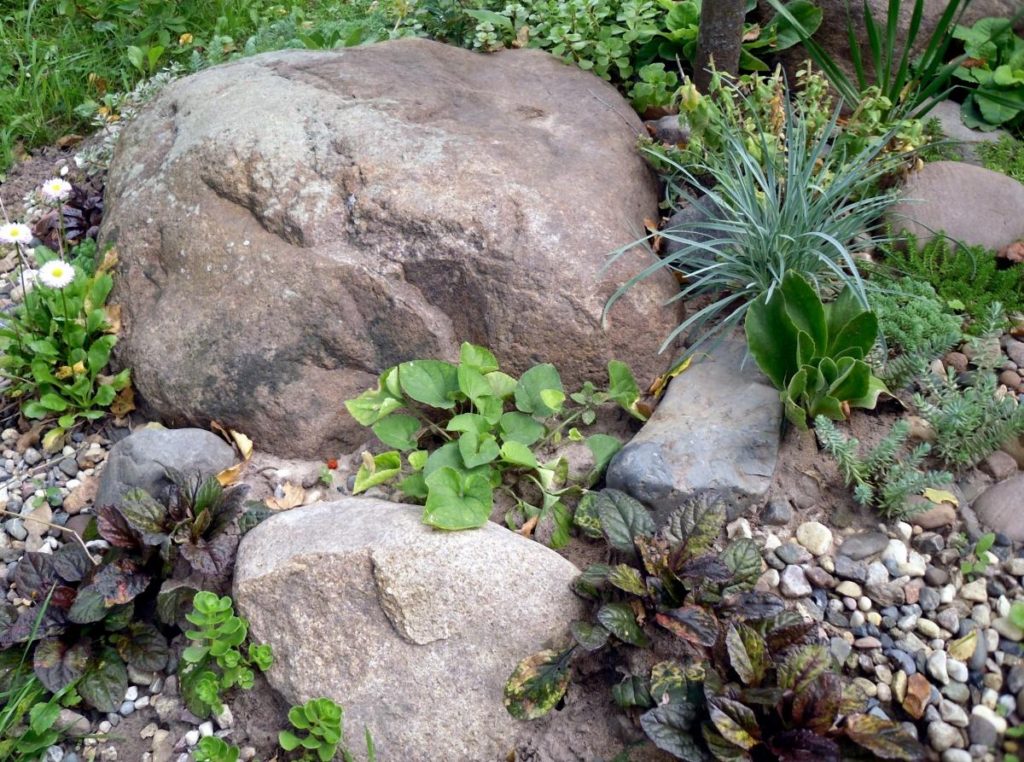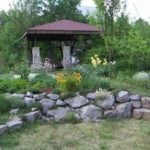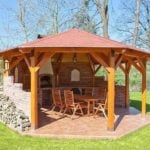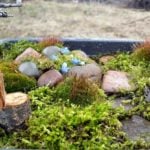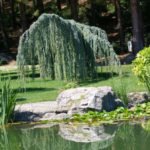Today I will tell you about the most important rules of rockery arrangement — those that will help make it not only beautiful, but also durable, and we – amateur gardeners – will be saved from unnecessary hassle and extra work.
The first rule: the basis, the basis and once again the basis!
Never spare the time and effort to build the right foundation for your rockery. How important this is, I have seen in practice twice, so I categorically declare: this rule is strictly necessary! However, it is also necessary to follow it wisely: first of all, we need to understand what kind of problems should be prevented.
Excess moisture in the soil
If the rockery is located on a site where water accumulates or stagnates in the spring or after rain, drainage is required. For its arrangement, sand, gravel, expanded clay, brick debris and construction debris are suitable – any available material. If you have set aside a place for a flower garden on a hill, the soil is sandy, and the water goes away instantly – you can do without a drainage layer.
Moles and shrews
If moles and shrews have been operating on your site, be sure to cover the foundation of future rockeries with a metal mesh made of wire mesh. I do not know what attracts these animals to buildings made of stones, but if there is at least one animal in the area digging tunnels in the soil, then it will certainly be here!
Weeds
It is often advised to remove the turf at the base of the future flower garden, cover the soil with geotextile or other nonwoven fabric. For what purpose? So that the soil layers do not mix, the soil is not washed, weeds do not germinate.
Subsidence of soil and displacement of stones
Another threat posed by the incorrect device of the rockery is that the stones may drown. To avoid this, the soil – especially under large boulders – must be carefully compacted.

The second rule: in rockery the main thing is stones
That’s right! Rockery is not just a “flower garden with stones”, as it is often perceived. Stones here are the main and primary element of the composition, plants only complement it, emphasize, enhance the impression. Therefore, the choice of material, and the location, and the mutual combination of stones – from huge boulders to small stones for dumping – are of fundamental importance.
How to choose? Again, let’s focus on the principles — based on them, you will successfully cope with the details yourself. The basic principles in this case are:
- decorativeness;
- durability;
- naturalness.

It is worth starting, perhaps, with naturalness. The most beautiful rockeries are those that most successfully imitate the natural landscape. Along the banks of the stream, natural, smooth, as if polished by water stones, and scree, rough, sculptural boulders look. Therefore, we need to understand what kind of landscape we want to create, and then take a closer look at what “building materials” nature uses in such cases. And choosing based on these observations is an almost win-win approach.
Decorativeness is a multifaceted concept. In addition to the expressiveness of form, texture, color, we must take into account how the elements of the future rockery will be combined with each other. Sometimes the whole composition can be built around one stone, impressive in its beauty – then the rest should be restrained, because their task is to emphasize the dignity and only.
In any case, avoid diversity. No matter how attractive each stone is in itself, a rockery is not a quarry or a chaotic pile of cobblestones, but a solid, finished composition, the elements of which should not compete with each other in any case.
By the way, naturalness and decorativeness are closely related to each other. Think, remember, have you ever seen in nature, for example, stones of the same size laid in a neat row? Personally, I have never met. But in the flower beds, which their creators call rockeries – very often! I admit that I have sinned myself. Here is another example of my mistakes:

Don’t hesitate: if you like it that way, don’t listen to anyone’s advice. After all, this is your garden, and you should like it first of all, not landscape designers. But most often such compositions are created simply by inertia or ignorance, but in fact mistakes are easy to avoid — just a little attention and observation.
Finally, durability. Here we are talking not only about whether the selected stone will not crumble from heavy rains and winter cold (if you choose those that are characteristic of your area, then this will most likely not happen in the next few decades). More importantly, some rocks (for example, sandstones, a little less often — limestones) tend to change their appearance under the influence of precipitation and climatic vagaries. Porous stones can absorb moisture, can be contaminated – this is important to understand and be sure to take into account.

The third rule is: choose very carefully the plants
Mountains of books and articles have been written about how to do this. And here we’ll talk a little bit about what not to do.
First: it is not necessary to plant aggressive plants in rockeries, fast-growing and occupying a vast space at the same time. No, in principle it is possible, but the understanding is that it will be additional work. Or the rockery is completely transformed in a couple of years: some particularly active species are able to completely cover even quite large stones.

Second: do not get carried away with plants whose decorative effect is very limited in time. For example, the bulbs of early spring among the stones look wonderful (but not for long). And withering foliage should not be plucked until it dries, turns yellow. In ordinary flower beds, this problem is easy to solve – it is enough to plant a number of plants with lush and beautiful foliage, which reliably masks the traces of wilting bulbs. In rockery, this trick is not always possible, so you need to choose the plants themselves and their combinations very carefully.

Of course, this is not all the rules and subtleties of arranging a rockery. You can talk a lot about its composition, the choice of location, how to harmoniously fit this very special flower garden into the surrounding landscape. You can discuss in detail the types and styles of rockeries – this is a separate big topic. But the three rules we are talking about today seem to me to be the most important and priority.
